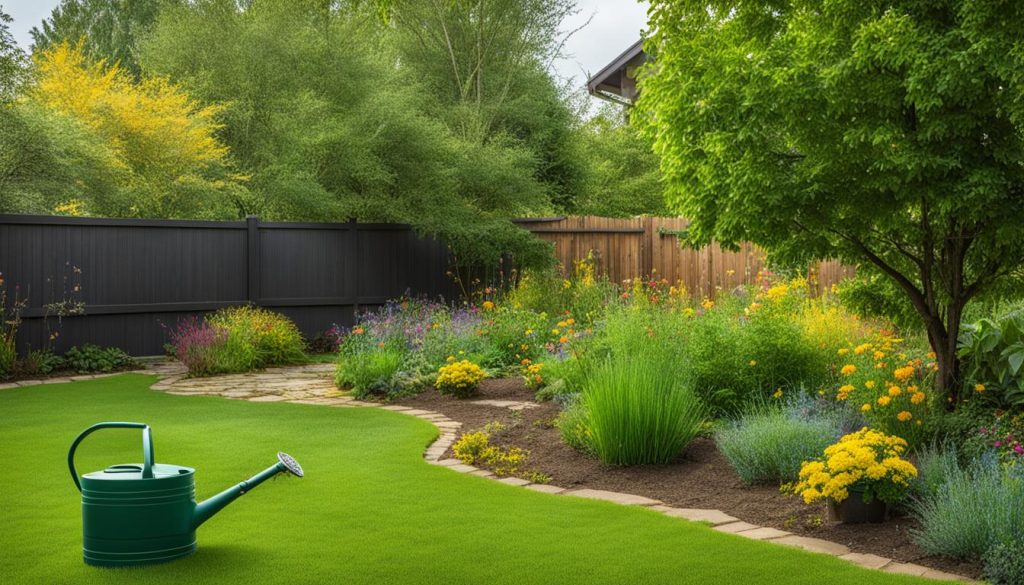Welcome to our guide on how to efficiently water your landscaping to promote a healthy Canadian garden. At Landscaping Vaughan, we understand the importance of using water wisely and conserving this precious resource. In this section, we will provide valuable watering tips to help you optimize water use while ensuring your garden thrives.
Water is essential for the growth and survival of plants, but overwatering can lead to water waste, plant diseases, and other issues. By following our expert advice, you can learn how to water your landscape effectively and sustainably. We believe that every Canadian garden can benefit from efficient water use, and we’re here to help you achieve that.
With our guidance, you can discover how to tailor your watering practices to match the specific needs of your landscape, including plant types, soil conditions, and climate. By understanding your landscape’s water needs, you can ensure that your gardening practices are efficient and environmentally friendly.
Stay tuned as we explore different watering techniques based on plant types, irrigation systems, smart watering schedules, mulching as a water-saving technique, and other essential tips for a sustainable Canadian garden. If you have any questions or need personalized advice tailored to your specific needs, don’t hesitate to contact us at Landscaping Vaughan.
Understanding Your Landscape’s Water Needs
Welcome back! Before diving into specific watering tips, it’s crucial to understand the water requirements of your landscape. Every landscape has unique water needs based on factors like plant types, soil conditions, and climate.
Firstly, let’s consider plant types. Different plants have different water requirements, which means you need to water them accordingly. For example, plants like succulents and cacti require less water than ferns and shrubs. Additionally, young plants typically require more water than established plants.
Soil conditions are also essential to consider. Soil characteristics like texture, structure and composition influence how much water your plants need, and how often they need it. Soil with higher sand content will drain water faster than clay soil, which retains moisture longer. Understanding your soil type can help you determine optimal watering practices.
Climate plays an important role as well. If you live in a hot, dry climate, your plants will likely require more water than if you live in a cooler, wetter environment. Additionally, sunlight exposure is another factor to consider when determining proper watering practices. Plants in shaded areas require less water than those in direct sunlight.
Summary
Understanding your landscape’s water needs is crucial before diving into watering techniques. Consider plant types, soil conditions, and climate when determining watering practices. By tailoring your watering to match your landscape’s needs, you can minimize waste and maximize the health of your plants.
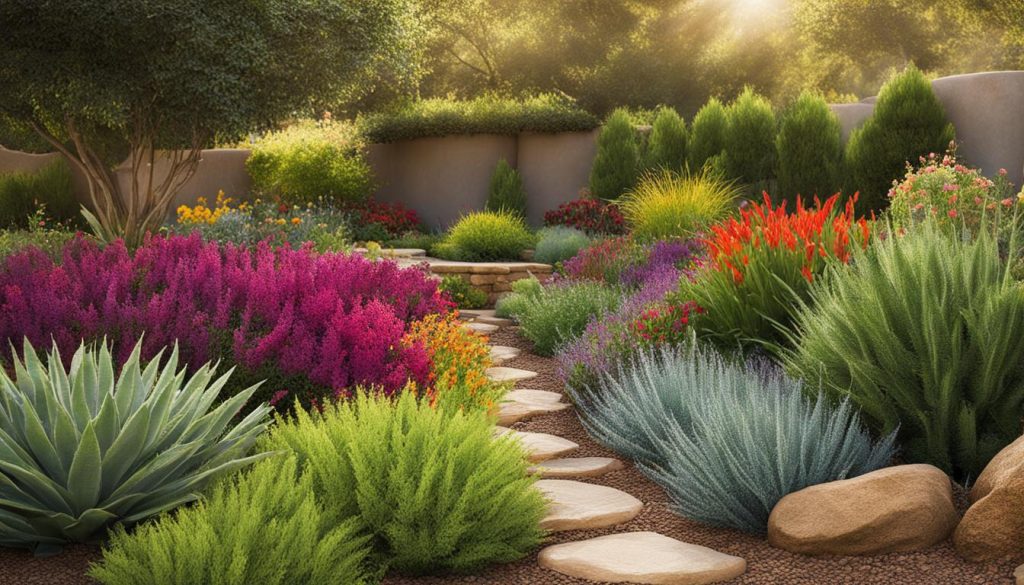
Watering Techniques for Different Plant Types
Efficient watering practices start with understanding the water requirements of your landscape, especially for different plant types. Different plants have different watering needs, based on factors such as their size, age, and root system. Here are some watering techniques to keep in mind:
Flowers
Flowers typically have shallow roots that require frequent watering, especially during hot weather. Ensure the soil stays moist, but not waterlogged, to promote healthy growth. Water at the base of the plant to avoid wetting the petals, which can lead to disease and pest infestation.
| Watering Techniques | How Often? |
|---|---|
| Hand watering or drip irrigation | 2-3 times a week, depending on the weather |
| Mulching | Apply a layer of 2-3 inches to retain moisture and regulate soil temperature |
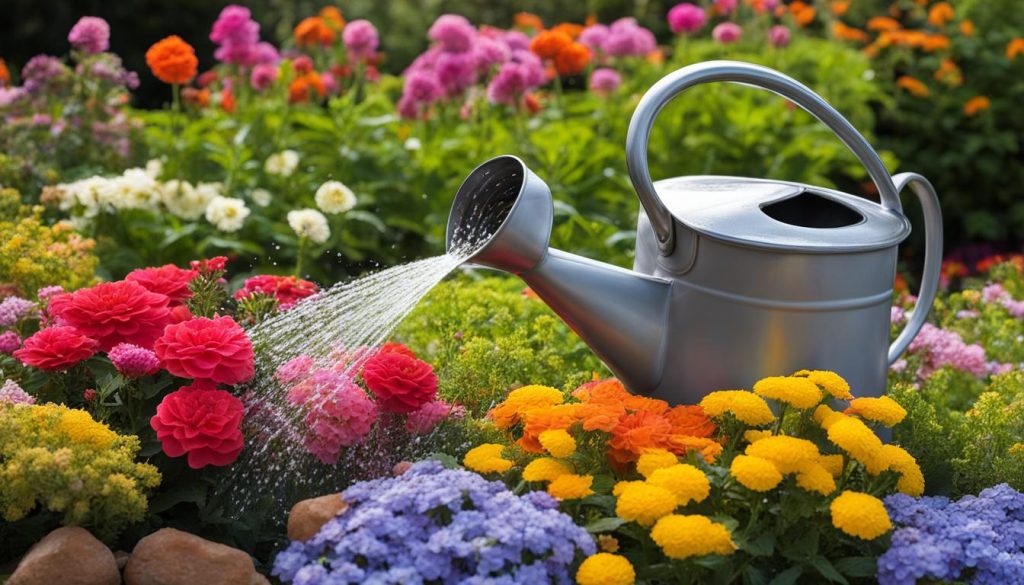
Shrubs and Hedges
Shrubs and hedges have deeper roots than flowers, so they require watering less frequently but for longer durations. Watering deeply encourages root growth and prevents shallow rooting, which increases susceptibility to drought and other stresses.
| Watering Techniques | How Often? |
|---|---|
| Soaker hoses or drip irrigation | Once a week, or every 2-3 weeks, depending on the weather |
| Water deeply for at least 30 minutes or more, depending on the soil type and age of the shrub |
Trees
Trees have an extensive root system, so they require the deepest watering technique to promote healthy growth and development. Watering too frequently can promote shallow rooting, so ensure soil stays moist for longer periods and avoid daily watering.
| Watering Techniques | How Often? |
|---|---|
| Soaker hoses or drip irrigation | Once every 2-4 weeks, depending on the weather and age of the tree |
| Water deeply for at least 1 hour, allowing water to penetrate the soil to a depth of 12 inches or more |
By using these techniques, you can ensure efficient watering practices that promote plant health while conserving water.
Irrigation Systems: Choosing the Right Option
When it comes to efficient watering, choosing the right irrigation system can make all the difference. By minimizing water waste, you can conserve resources and reduce your environmental impact while maintaining a healthy landscape. At Landscaping Vaughan, we offer a variety of irrigation systems to suit your specific needs.
The type of irrigation system you choose will depend on factors such as the size and layout of your garden, the types of plants you have, and your budget. Here are some options to consider:
| Irrigation System | Benefits | Installation | Maintenance |
|---|---|---|---|
| Drip Irrigation | – Slow, steady delivery of water directly to the roots – Minimizes water waste and evaporation – Ideal for vegetable gardens and flower beds |
– Can be installed above or below ground – Can be customized to fit any garden layout |
– Check for clogs or leaks regularly – Replace damaged tubing as needed |
| Sprinklers | – Covers large areas quickly and efficiently – Ideal for lawns and larger gardens |
– Requires a connection to a water source – Must be positioned properly to avoid overspray |
– Check for damaged or blocked heads regularly – Adjust watering schedule for seasonal changes |
| Soaker Hoses | – Delivers water directly to the soil – Great for gardens with closely-spaced plants |
– Can be laid on the ground or buried slightly – Must be positioned properly to avoid gaps or overlaps |
– Check for leaks or cracks regularly – Replace hoses every few years |
Whichever system you choose, it’s important to install it properly and maintain it regularly. This will help ensure that your irrigation system is functioning at its best, delivering water efficiently and effectively.
At Landscaping Vaughan, we can help you choose and install the right irrigation system for your garden.
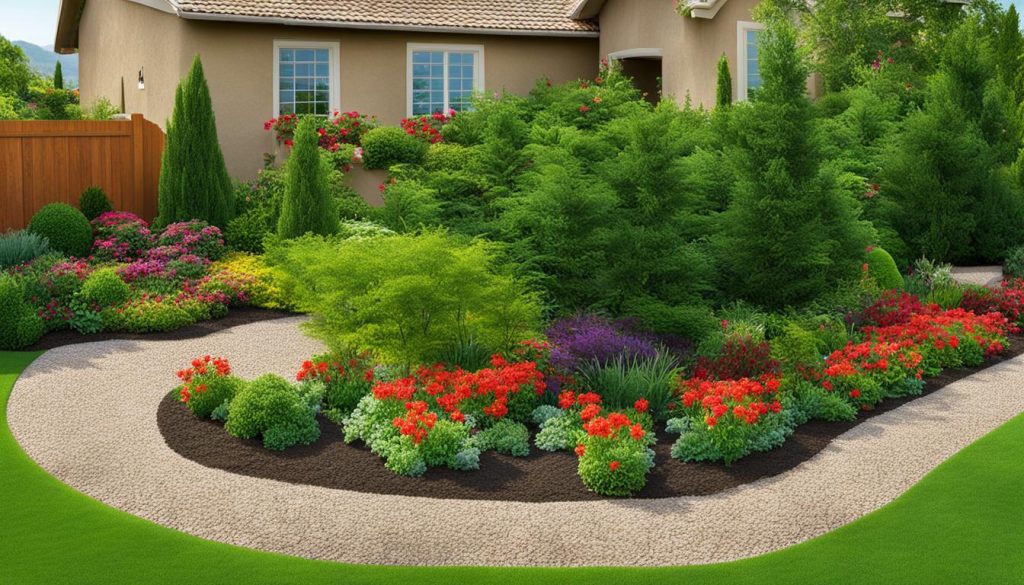
Smart Watering Schedules
Creating a smart watering schedule is crucial to ensure efficient watering practices and conserve water. By scheduling your watering, you can avoid overwatering and promote healthy plant growth. Here are some tips for creating a smart watering schedule:
- Consider the weather: Adjust your watering schedule based on the weather conditions. If it has rained recently, delay watering until the soil dries out. Also, watering during cooler times of the day can reduce water evaporation.
- Check soil moisture: Determine soil moisture by inserting a garden trowel or shovel into the soil. If the soil is moist, delay watering. If it is dry, it’s time to water your plants.
- Tailor watering practices to plant needs: Different plants have different water requirements. For instance, succulents need watering less frequently than annuals. Determine the watering needs of your plants and adjust your schedule accordingly.
Creating a smart watering schedule can seem daunting, but it doesn’t have to be. Here’s an example of a simple watering schedule:
| Plant Type | Watering Schedule |
|---|---|
| Lawn | 1 inch of water per week, split into two watering sessions |
| Flowers and vegetables | Water deeply twice a week |
| Shrubs and trees | Water deeply once a week |
Remember, the key to a smart watering schedule is to tailor it to your landscape’s specific needs. By following these tips, you can promote healthy plant growth while conserving water.
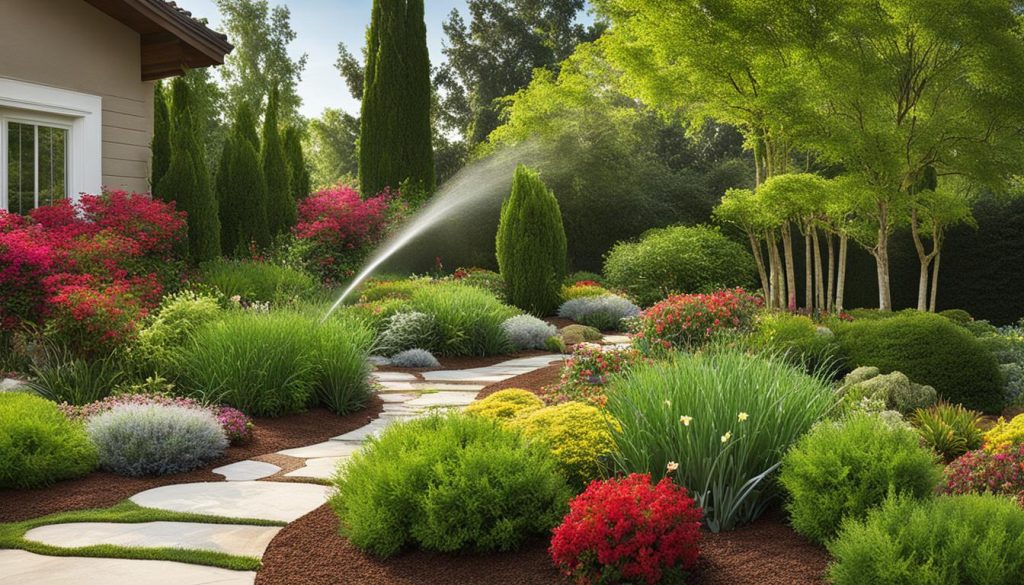
Mulching: An Essential Water-Saving Technique
If you’re looking for an effective water-saving technique for your Canadian garden, mulching is a must-try. This practice involves covering your soil with a layer of organic material, such as bark, leaves, or grass clippings. Not only does it help retain moisture in the soil, but it also reduces water evaporation, suppresses weed growth, and moderates soil temperature.
Using mulch in your landscaping can help you conserve water by reducing your watering needs. The layer of mulch helps to prevent water from evaporating, keeping your soil moist for longer periods. This means you can water less frequently and still maintain healthy plants.
When it comes to applying mulch, there are a few things to keep in mind. Firstly, it’s crucial to choose the right type of mulch for your garden. This depends on your landscape’s soil type, climate, and plant types. For example, if you have acid-loving plants, you may want to consider using pine needles as mulch. On the other hand, if you have a vegetable garden, you can opt for straw or compost.
Secondly, ensure that the mulch is applied correctly. It’s essential to spread it evenly and maintain a layer of around 2-3 inches thick. Applying too little mulch won’t provide the necessary benefits, while applying too much can suffocate your plants and cause them to stress.
| Type of Mulch | Benefits |
|---|---|
| Shredded Bark | Long-lasting, attractive, and provides good weed control |
| Grass Clippings | Free and provides a good source of nitrogen |
| Compost | Rich in nutrients, improves soil quality and structure |
| Straw | Provides excellent weed control and moisture retention |
Lastly, remember to replenish your mulch layer periodically. Over time, the mulch will break down and decompose, losing its effectiveness. Adding a new layer annually will help maintain its benefits and conserve water in the long run.
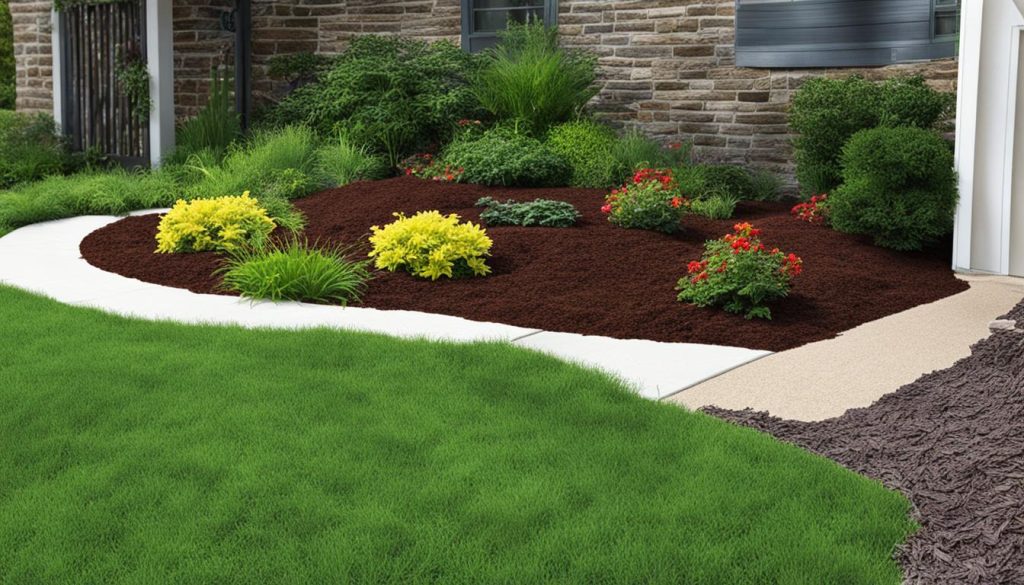
Key Takeaways:
- Mulching is an effective water-saving technique that can significantly reduce your landscape’s watering needs.
- Choosing the right type of mulch for your garden depends on your soil type, climate, and plant types.
- Ensure the mulch is applied evenly and at the right thickness to maximize its benefits.
- Replenish your mulch layer annually to maintain its effectiveness.
Watering Tips for a Sustainable Canadian Garden
At Landscaping Vaughan, we believe in promoting sustainable practices for maintaining a healthy Canadian garden. Water conservation is a crucial aspect of sustainability, and by implementing some simple watering tips, you can significantly reduce water consumption while still enjoying a thriving landscape.
Collect and Reuse Rainwater
One way to reduce your water footprint is by collecting rainwater in a barrel or container and using it to water your plants. This method not only conserves water but also provides plants with a natural source of nutrients. Place your rain barrel under a downspout to collect water from your roof. In addition to reducing water waste, this practice also helps reduce the risk of flooding and erosion by diverting excess water away from your property.
Choose Native Plants
Native plants are well-suited to the Canadian climate and require less water than non-native species. They have adapted to local conditions, making them more resilient to drought and more likely to thrive without excessive watering. In addition, native species provide essential habitat for local wildlife, contributing to a healthy ecosystem in your garden.
Avoid Overwatering
Overwatering is a common mistake that can lead to water waste and plant damage. To avoid this, make sure you understand your landscape’s water needs (as discussed in section two) and create a smart watering schedule (as discussed in section five). Additionally, be sure to check the soil moisture level regularly and water only when necessary. A good rule of thumb is to water deeply and less frequently rather than lightly and frequently.
Mulch Your Plants
Mulching is an excellent water-saving technique that helps retain moisture in the soil and reduce water evaporation (as discussed in section six). In addition, mulch helps regulate soil temperature and suppresses weed growth, making it an all-around beneficial practice for a sustainable garden. Choose organic mulch options like shredded leaves or bark, which provide additional nutrients to the soil as they decompose.
Use Water-Efficient Tools and Techniques
There are various water-efficient tools and techniques available to help you reduce water waste in your garden. For example, consider using a drip irrigation system (as discussed in section four) or a soaker hose, which deliver water directly to the roots of your plants without wasting any. You can also use a rain gauge to measure rainfall and avoid watering unnecessarily.
By following these sustainable watering tips, you can conserve water and help create a healthy, thriving Canadian garden.
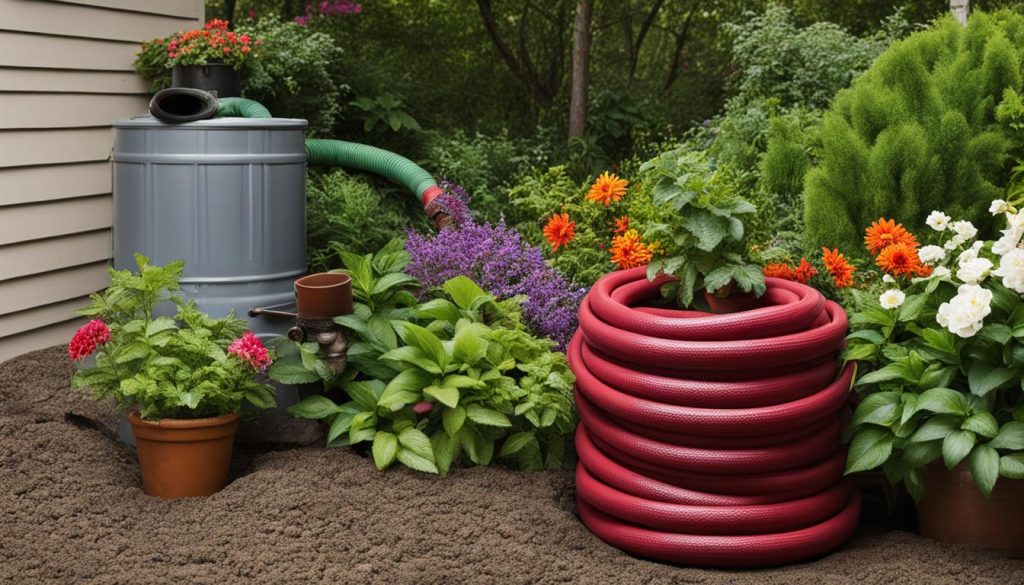
Contact Us for Expert Advice
We hope our article on landscaping watering tips has been helpful in promoting efficient water use in your Canadian garden. While we’ve covered extensive details on watering techniques, irrigation systems, and sustainable practices, we understand that every landscape is unique, and you may have specific questions or concerns.
At Landscaping Vaughan, we’re committed to providing expert advice that is tailored to your landscape’s specific needs. Our team of professionals has extensive experience in designing, installing, and maintaining landscapes in the Canadian climate.
If you have any queries regarding our article or need further guidance on how to optimize water use in your garden, we encourage you to contact us. Our experts are here to help you with personalized advice and solutions that suit your landscape and budget.
For more information on how we can help you create a sustainable and lush Canadian garden, call us at (647) 812-8594 today. Whether you need advice on watering techniques, irrigation systems, or landscape design, our team is here to assist you every step of the way.
Don’t wait any longer to create the garden of your dreams. Get in touch with us today to schedule a consultation and learn how we can turn your landscape into a beautiful, water-efficient oasis.
FAQ
How often should I water my plants?
The frequency of watering depends on several factors, including plant type, soil conditions, and weather. As a general rule, it’s best to water deeply and less frequently rather than shallow and frequent waterings. Monitor the moisture levels of your soil and adjust your watering schedule accordingly.
What time of day is best for watering?
Early morning or late afternoon is the ideal time for watering. This allows the water to penetrate the soil before it evaporates in the heat of the day. Avoid watering during the hottest part of the day to minimize water loss through evaporation.
Should I water my lawn every day?
Lawns typically require about 1-1.5 inches of water per week, including rainfall. Instead of daily watering, it’s better to deep water once or twice a week. This promotes the growth of deep roots and encourages a healthier, more drought-resistant lawn.
How can I tell if my plants need water?
There are a few signs to look out for. Check the soil moisture by sticking your finger about an inch into the ground. If it feels dry, it’s time to water. Wilting leaves or drooping plants are also indicators of insufficient water. However, be careful not to overwater, as this can lead to root rot.
Can I use a sprinkler for watering?
Sprinklers are a common and effective way to water large areas. However, they can lead to water loss through evaporation and can be inefficient if not properly designed and maintained. Consider using a smart sprinkler system that adjusts watering based on weather conditions and soil moisture levels to conserve water.
Is it better to hand-water or use irrigation systems?
Both methods have their pros and cons. Hand-watering allows you to target specific plants and conserve water, but it can be time-consuming for larger areas. Irrigation systems, such as drip irrigation or soaker hoses, provide efficient water distribution and can save time. Consider your landscape’s size and your watering preferences when choosing the method.
What is mulching, and how does it help conserve water?
Mulching involves placing a layer of organic material, such as wood chips or straw, on the soil surface around plants. Mulch helps retain soil moisture, reduces evaporation, suppresses weed growth, and regulates soil temperature. It acts as a natural barrier to conserve water and promote plant health.
How can I collect rainwater for watering my garden?
Installing a rain barrel is an excellent way to collect rainwater from your roof’s downspouts. This collected water can then be used for watering your plants. Make sure to position the rain barrel correctly and cover it to prevent mosquito breeding and debris contamination.
Can I reuse household water for my garden?
Yes, you can reuse water from activities like washing dishes or laundry to water your plants. This is known as graywater recycling and can be done with proper filtration and treatment systems. However, ensure that the detergents used are safe for plants and avoid using water contaminated with harsh chemicals.
How can I prevent water runoff and waste?
To prevent water runoff, use techniques such as adding organic matter to improve soil structure, creating gentle slopes, and using mulch to retain moisture. Additionally, consider installing rain gardens or catch basins to capture and filter runoff water. These measures help minimize water waste and protect the environment.

